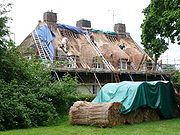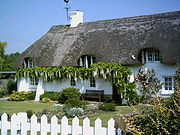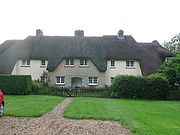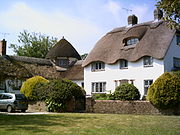
Briantspuddle
Encyclopedia

Dorset
Dorset , is a county in South West England on the English Channel coast. The county town is Dorchester which is situated in the south. The Hampshire towns of Bournemouth and Christchurch joined the county with the reorganisation of local government in 1974...
, England
England
England is a country that is part of the United Kingdom. It shares land borders with Scotland to the north and Wales to the west; the Irish Sea is to the north west, the Celtic Sea to the south west, with the North Sea to the east and the English Channel to the south separating it from continental...
situated within the Piddle Valley
River Piddle
The River Piddle or Trent or North River is a small rural Dorset river which rises next to Alton Pancras church and flows south and then south-easterly more or less parallel with its bigger neighbour, the River Frome, to Wareham, where they both enter Poole Harbour via...
near to the villages of Affpuddle
Affpuddle
Affpuddle is a small village and civil parish in the Purbeck district of Dorset in South West England, east of Dorchester. The local travel links are from the village to Moreton railway station and to Bournemouth International Airport. Part of the village street is the B3390, which divides the...
, Tolpuddle
Tolpuddle
Tolpuddle is a small village in the southern English county of Dorset, situated in the Piddle valley, eight miles east of Dorchester and 12 miles west of Poole. The village has a population of 331 ....
and Puddletown
Puddletown
Puddletown is a village in Dorset, England, 5 miles east of Dorchester in the River Piddle valley. The village has a population of 1,177 , of which 30.3% are retired....
and approximately eight miles east of the county town of Dorchester. The village takes its name from Brian de Turberville, who was lord of the manor
Lord of the Manor
The Lordship of a Manor is recognised today in England and Wales as a form of property and one of three elements of a manor that may exist separately or be combined and may be held in moieties...
during the reign of Edward III
Edward III of England
Edward III was King of England from 1327 until his death and is noted for his military success. Restoring royal authority after the disastrous reign of his father, Edward II, Edward III went on to transform the Kingdom of England into one of the most formidable military powers in Europe...
and is in the Purbeck
Purbeck Hills
The Purbeck Hills and South Dorset Downs are a ridge of chalk downs in Dorset, England. The hills extend from the Dorset Downs west of Dorchester, where the River Frome begins to form a valley dividing them from the larger area of downland to the north. The ridge then runs east through the Isle...
conservation. With a population of around 200, Briantspuddle was developed as a model village and is noted for its thatched cottages and village hall.
History

Domesday Book
Domesday Book , now held at The National Archives, Kew, Richmond upon Thames in South West London, is the record of the great survey of much of England and parts of Wales completed in 1086...
in 1086 as having "land for three ploughs, a mill, thirty eight acres of meadow, 12 acres (48,562.3 m²) of woodland, eleven furlongs of pasture in length and 12 in width." This was valued at £4 and Godric was in charge of "about a dozen people who worked the land".

Christchurch Priory
Christchurch Priory is an ecclesiastical parish and former priory church in Christchurch in the English county of Dorset .-Early history:...
, the Frampton family and the Turberville family. In 1683 William Frampton united the manors of Throop, Briantspuddle and Affpuddle into a single estate.
In 1914 financial hardship forced the Frampton family to sell part of their estate, including the village of Briantspuddle, to Sir Ernest Debenham
Ernest Debenham
Sir Ernest Ridley Debenham, 1st Baronet , was a British businessman. He was responsible for the considerable expansion of the family's retail and wholesale drapery firm between 1892 and 1927....
, (grandson of William Debenham, founder of the British department store Debenhams
Debenhams
Debenhams plc is a British retailer operating under a department store format in the UK, Ireland and Denmark, and franchise stores in other countries. The Company was founded in the eighteenth century as a single store in London and has now grown to around 160 shops...
).
A Model Village

Many of the houses in the village are constructed from specially hand made 'airspaced' concrete blocks which were produced locally. These reduced the need for foundations and aimed to insulate by the air gaps and over 200,000 were produced annually. The consistency of the design of these new houses with traditional Dorset building styles has created a rare example of a "model village", particularly in the Bladen Valley area. Unusually, the house numbers in the village were based on the order in which rent was collected, rather that the more traditional sequence of odd and even numbers.
The Bladen Farms were an experiment to prove that under modern conditions it was possible for Dorset to produce a larger proportion of home-grown foods, especially of animal origin, than it did previously. Ernest Debenham argued that that this would "readjust the balance of population and enable a larger number of workers to live on the land". His plan was to support smaller neighbouring farms with special facilities that could provide economies of scale. This 'demonstration farm' replaced "middlemen and intermediaries" and the project was very successful at pasteurisation and other successes included egg production, electricity generation and selective breeding of livestock (as a result of which many prize winning sheep and cattle were produced), forestry
Forestry
Forestry is the interdisciplinary profession embracing the science, art, and craft of creating, managing, using, and conserving forests and associated resources in a sustainable manner to meet desired goals, needs, and values for human benefit. Forestry is practiced in plantations and natural stands...
, bee-keeping, and a farm veterinary service. Following Debenham's death in 1952 the estate was broken up and sold.

Notable buildings
- The dairy (known locally as ‘the Ring’) was the first to have large scale milking machines installed in Dorset. In the 1920’s up to 1,000 gallons of milk a day were brought in from surrounding farms for processing and bottling.
- There is no longer any dairy farm, most local dairy enterprise having succumbed to the complex milk monopoly. Beef production has replaced dairying as a much smaller income for local farmers, as well as horse farming.
- The village hall is a converted thatched barn, rebuilt in 1803 by James Frampton and purchased by the parish Council in 1953.
- Cruck cottage is the oldest building in the village, dating back to 1620 and is so called because it has the original ‘cruck beam’ from ground to roof.

- The sculptor and artist Eric GillEric GillArthur Eric Rowton Gill was a British sculptor, typeface designer, stonecutter and printmaker, who was associated with the Arts and Crafts movement...
(whose brother MacDonald Gill designed several houses in the village) was commissioned by Ernest Debenham to sculpt the ‘Madonna and Child’ war memorial in situ starting in January 1918 and completing the work an August. A column of Portland stone, the unusual memorial has an inscription from the fifteenth century mystic Julian of NorwichJulian of NorwichJulian of Norwich is regarded as one of the most important English mystics. She is venerated in the Anglican and Lutheran churches, but has never been canonized, or officially beatified, by the Catholic Church, probably because so little is known of her life aside from her writings, including the...
:
It is sooth that sin is cause of all this pain but all shall be well and all shall be well all manner of thing shall be well.
The cross was dedicated by the Bishop of Salisbury one day after the Armistice
Armistice
An armistice is a situation in a war where the warring parties agree to stop fighting. It is not necessarily the end of a war, but may be just a cessation of hostilities while an attempt is made to negotiate a lasting peace...
was signed in 1918.

